Antimicrobial Susceptibility Profiles of Campylobacter jejuni and Campylobacter coli Isolated from Processed Chickens and Turkeys in Morocco
Abstract
1. Introduction
2. Materials and Methods
2.1. Ethical Statement
2.2. Study Area
2.3. Sample Collection
2.4. Culture and Growth Conditions
2.5. Biochemical Identification
2.5.1. Culture Characteristics
2.5.2. Biochemical Reactions
2.6. Confirmation of Campylobacter Species
2.7. Antimicrobial Susceptibility Testing
2.8. Detection of Tet(O) Gene by Conventional PCR
2.9. Statistical Analysis
2.10. Quality Assurance
3. Results
3.1. Strain Identification
3.2. Occurrence of Campylobacter Species in Various Samples
3.3. Antimicrobial Susceptibility Testing
3.4. Molecular Detection of Tetracycline Resistance
4. Discussion
5. Conclusions
Author Contributions
Funding
Institutional Review Board Statement
Informed Consent Statement
Data Availability Statement
Acknowledgments
Conflicts of Interest
Abbreviations
| AMP | Ampicillin |
| AMC | Amoxicilin/Clavulanic acid |
| BTS | Bacterial Test Standard |
| CN | Gentamicin |
| CIP | Ciprofloxacin |
| E | Erytromycin |
| TE | Tetracyclin |
| MDR | Multidrug resistance |
| MALDI TOF MS | Matrix-Assisted Lazer Desorption Ionization Time of Flight Mass Spectrometry |
References
- Interprofessional Poultry Industry Sectors Confederation. Statistics of the Sector. 2017. Available online: https://www.fisamaroc.org.ma (accessed on 27 March 2025).
- Law no. 49-99. The health protection of poultry farms and the control of the production and marketing of poultry products. 2002. Bulletin Official no.5036, 5 September 2002; pp. 901–903.
- Gahamanyi, N.; Mboera, L.E.G.; Matee, M.I.; Mutangana, D.; Komba, E.V.G. Prevalence, Risk Factors, and Antimicrobial Resistance Profiles of Thermophilic Campylobacter Species in Humans and Animals in Sub-Saharan Africa: A Systematic Review. Int. J. Microbiol. 2020, 12, 2092478. [Google Scholar] [CrossRef] [PubMed]
- Baaboua, A.E.; Maadoudi, M.E.; Bouyahya, A.; Abrini, J. Intestinal infections of Campylobacter: A review. Microbiol. Res. J. Int. 2017, 18, 1–8. [Google Scholar] [CrossRef]
- European Food Safety Authority (EFSA). EFSA Explains Zoonotic Diseases: Campylobacter; EFSA: Parma, Italy, 2014. Available online: https://www.efsa.europa.eu/en/efsatopics/topic/campylobacter (accessed on 27 March 2025).
- Atanassova, V.; Reich, F.; Beckmann, L.; Klein, G. Prevalence of Campylobacter spp. in turkey meat from a slaughterhouse and in turkey meat retail products. FEMS Immunol. Med. Microbiol. 2007, 49, 141–145. [Google Scholar] [CrossRef] [PubMed]
- Sáenz, Y.; Zarazaga, M.; Lantero, M.; Gastanares, M.J.; Baquero, F.; Torres, C. Antibiotic resistance in Campylobacter strains isolated from animals, foods, and humans in Spain in 1997–1998. Antimicrob. Agents Chemother. 2000, 44, 267–271. [Google Scholar] [CrossRef] [PubMed]
- Sithole, V.; Amoako, D.G.; Abia, A.L.K.; Perrett, K.; Bester, L.A.; Essack, S.Y. Occurrence, antimicrobial resistance, and molecular characterization of Campylobacter spp. In intensive pig production in South Africa. Pathogens 2021, 10, 439. [Google Scholar] [CrossRef]
- Seiffert, S.N.; Hilty, M.; Perreten, V.; Endimiani, A. Extended-spectrum cephalosporin-resistant gram-negative organisms in livestock: An emerging problem for human health. Drug Resist. Updates 2014, 16, 22–45. [Google Scholar] [CrossRef]
- O’Neill, J. Tackling Drug-Resistant Infections Globally: Final Report and Recommendations; Review on Antimicrobial Resistance: London, UK, 2016. [Google Scholar]
- ISO 10272-1:2017; Microbiology of the Food Chain—Horizontal Method for Detection and Enumeration of Campylobacter spp.—Part 1: Detection Method. International Organization for Standardization: Geneva, Switzerland, 2017.
- French Society for Microbiology (SFM). Committee on Antimicrobial Susceptibility Testing of the French Society for Microbiology (CASFM)–EUCAST 2023. V1.0; SFM: Paris, France, 2023; Available online: https://www.sfm-microbiologie.org/wp-content/uploads/2023/06/CASFM2023_V1.0.pdf (accessed on 30 April 2025).
- El-Adawy, H.; Hotzel, H.; Düpre, S.; Tomaso, H.; Neubauer, H.; Hafez, H.M. Determination of Antimicrobial Sensitivities of Campylobacter jejuni Isolated from Commercial Turkey Farms in Germany. Avian Diseases 2012, 56, 685–692. [Google Scholar] [CrossRef]
- El Baaboua, A.; El Maadoudi, M.; Bouyahya, A.; Kounnoun, A.; Bougtaib, H.; Belmehdi, O.; SkaliSenhaji, N.; Abrini, J. Prevalence and antimicrobial profiling of Campylobacter spp. isolated from meats, animal, and human feces in Northern of Morocco. Int. J. Food Microbiol. 2021, 349, 109202. [Google Scholar] [CrossRef]
- Pillay, S.; Amoako, D.G.; Abia, A.L.K.; Somboro, A.M.; Shobo, C.O.; Perrett, K.; Bester, L.A.; Essack, S.Y. Characterisation of Campylobacter spp. Isolated from Poultry in KwaZulu-Natal, South Africa. Antibiotics 2020, 9, 42. [Google Scholar] [CrossRef]
- Es-Soucratti, K.; Hammoumi, A.; Bouchrif, B. Occurrence and antimicrobial resistance of Campylobacter jejuni isolates from poultry in Casablanca-Settat, Morocco. Ital. J. Food Saf. 2020, 9, 8692. [Google Scholar] [CrossRef]
- Asmai, R.; Karraouan, B.; Es-Soucratti, K.; En-Nassiri, H.; Bouchrif, B.; Karib, H.; Triqui, R. Prevalence and antibiotic resistance of Campylobacter coli isolated from broiler farms in the Marrakesh Safi region, Morocco. Vet. World 2020, 13, 1892–1897. [Google Scholar] [CrossRef] [PubMed]
- Bort, B.; Martí, P.; Mormeneo, S.; Mormeneo, M.; Iranzo, M. Prevalence and Antimicrobial Resistance of Campylobacter spp. Isolated from Broilers Throughout the Supply Chain in Valencia, Spain. Foodborne Pathog. 2022, 19, 717–724. [Google Scholar] [CrossRef] [PubMed]
- Zhao, C.; Ge, B.; De Villena, J.; Sudler, R.; Yeh, E.; Zhao, S.; White, D.G.; Wagner, D.; Meng, J. Prevalence of Campylobacter spp., Escherichia coli, and Salmonella Serovars in Retail Chicken, Turkey, Pork, and Beef from the Greater Washington, DC, Area. Appl. Environ. Microbiol. 2001, 67, 5431–5436. [Google Scholar] [CrossRef] [PubMed]
- Tajada, P.; Gomez-Graces, J.L.; Alós, J.I.; Balas, D.; Cogollos, R. Antimicrobial susceptibilities of Campylobacter jejuni and Campylobacter coli to 12 beta-lactam agents and combinations with beta-lactamase inhibitors. Antimicrob. Agents Chemother. 1996, 40, 1924–1925. [Google Scholar] [CrossRef]
- Alfredson, D.A.; Korolik, V. Isolation and Expression of a Novel Molecular Class D β-Lactamase, OXA-61, from Campylobacter jejuni. Antimicrob. Agents Chemother. 2005, 49, 2515–2518. [Google Scholar] [CrossRef]
- Gaudreau, C.L.; Lariviere, L.A.; Lauzer, J.C.; Turgeon, F.F. Effect of clavulanic acid on susceptibility of Campylobacter jejuni and Campylobacter coli to eight beta-lactam antibiotics. Antimicrob. Agents Chemother. 1987, 31, 940–942. [Google Scholar] [CrossRef]
- Iovine, N.M. Resistance mechanisms in Campylobacter jejuni. Virulence 2013, 4, 230–240. [Google Scholar] [CrossRef]
- Gharbi, M.; Béjaoui, A.; Hamda, C.B.; Ghedira, K. Distribution of virulence and antibiotic resistance genes in Campylobacter jejuni and Campylobacter coli isolated from broiler chickens in Tunisia. J. Microbiol. 2022, 55, 1273–1282. [Google Scholar] [CrossRef]
- Nguyen, T.N.M.; Hotzel, H.; El-Adawy, H.; Tran, H.; Le, M.T.H.; Tomaso, H.; Neubauer, H.; Hafez, H.M. Genotyping and antibiotic resistance of thermophilic Campylobacter isolated from chicken and pig meat in Vietnam. Gut Pathog. 2016, 8, 19. [Google Scholar] [CrossRef]
- Alonso, R.; Mateo, E.; Churruca, E.; Martinez, I.; Girbau, C.; Fernandez-Astorga, A. MAMA-PCR assay for the detection of point mutations associated with high-level erythromycin resistance in Campylobacter jejuni and Campylobacter coli strains. J. Microbiol. Methods 2005, 63, 99–103. [Google Scholar] [CrossRef]
- Zhao, S.; Tyson, G.H.; Chen, Y.; Li, C.; Mukherjee, S.; Young, S.; Lam, C.; Folster, J.P.; Whichard, J.M.; McDermott, P.F. Whole-Genome Sequencing Analysis Accurately Predicts Antimicrobial Resistance Phenotypes in Campylobacter spp. ASM J. 2016, 82, 459–466. [Google Scholar] [CrossRef] [PubMed]
- Taylor, D.E.; Jerome, L.J.; Grewal, J.; Chang, N. Tet(O), a protein that mediates ribosomal protection to tetracycline, binds, and hydrolyses GTP. Can. J. Microbiol. 1995, 41, 965–970. [Google Scholar] [CrossRef]
- Schreyer, M.E.; Olivero, C.R.; Rossler, E.; Soto, L.P.; Frizzo, L.S.; Zimmermann, J.A.; Signorini, M.L.; Virginia, Z.M. Prevalence and antimicrobial resistance of Campylobacter jejuni and C. coli identified in a slaughterhouse in Argentina. Curr. Res. Food Sci. 2022, 5, 590–597. [Google Scholar] [CrossRef]
- Abdi-Hachesoo, B.; Khoshbakht, R.; Sharifiyazdi, H.; Tabatabaei, M.; Hosseinzadeh, S.; Asasi, K. Tetracycline Resistance Genes in Campylobacter jejuni and C.coli Isolated From Poultry Carcasses. Jundishapur J. Microbiol. 2014, 7, e12129. [Google Scholar] [CrossRef] [PubMed]
- Benites, C.; Anampa, D.; Torres, D.; Avalos, I.; Rojas, M.; Conte, C.; Lázaro, C. Prevalence, Tetracycline Resistance and Tet(O) Gene Identification in Pathogenic Campylobacter Strains Isolated from Chickens in Retail Markets of Lima, Peru. Antibiotics 2022, 11, 1580. [Google Scholar] [CrossRef]

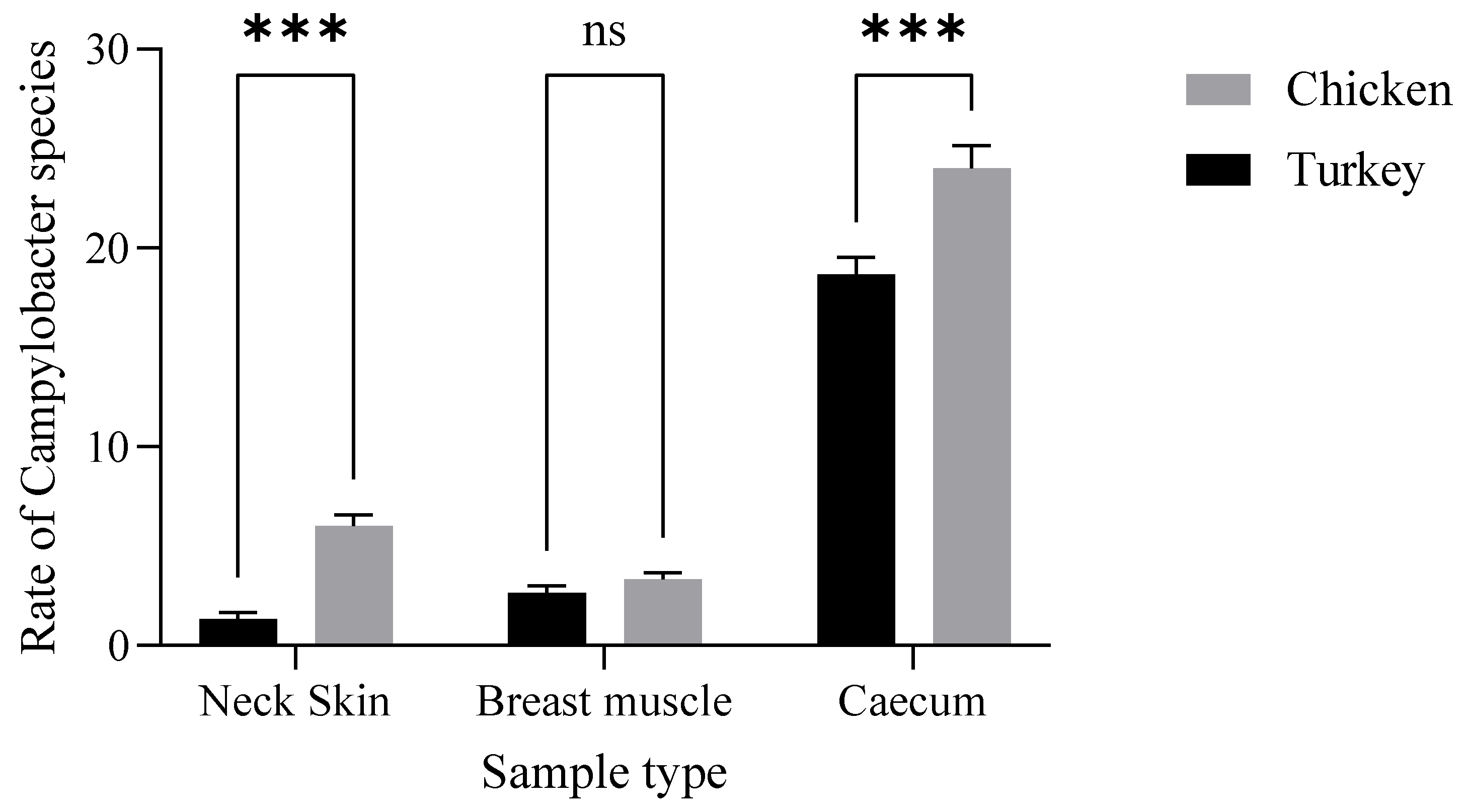
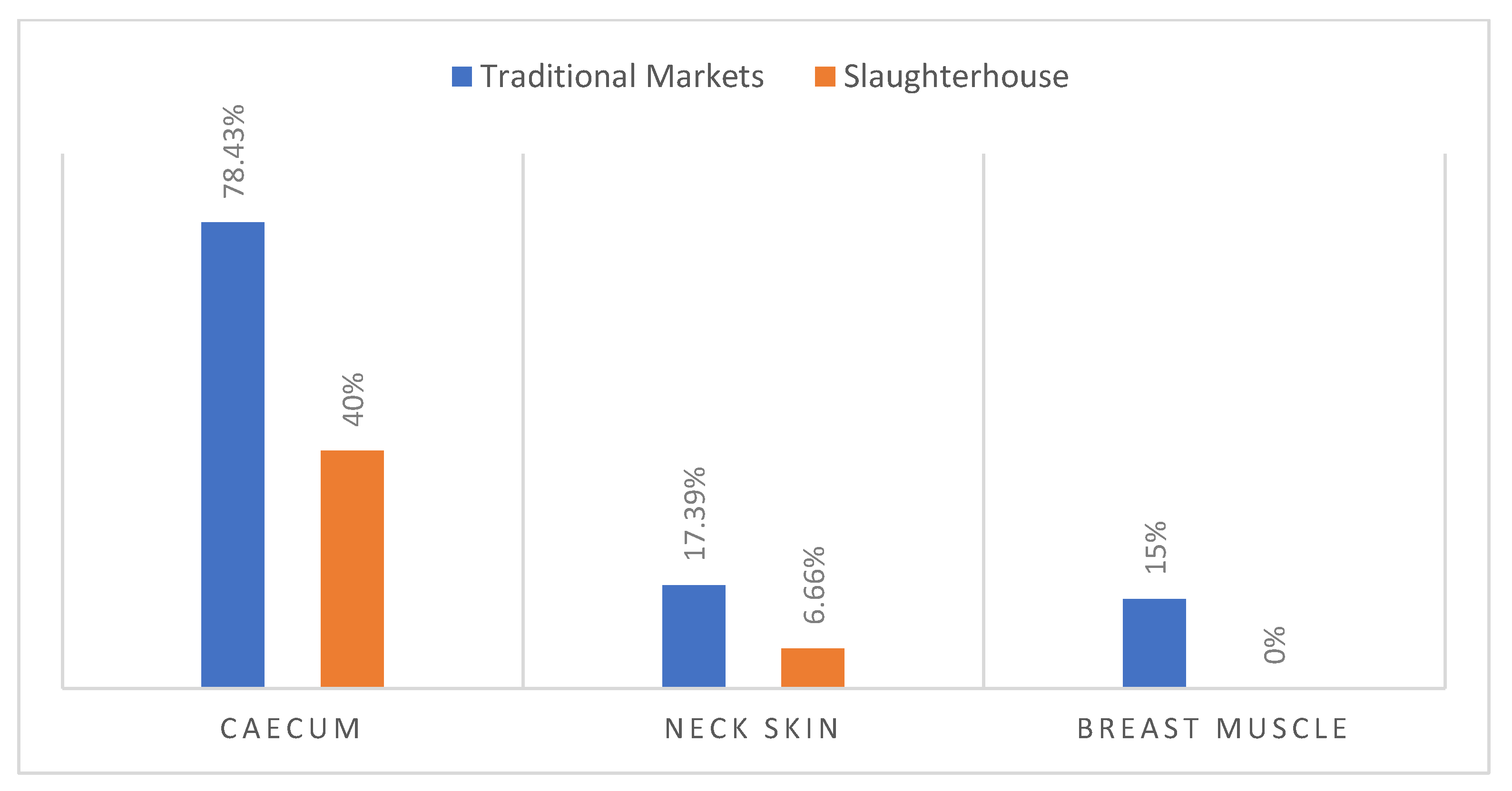
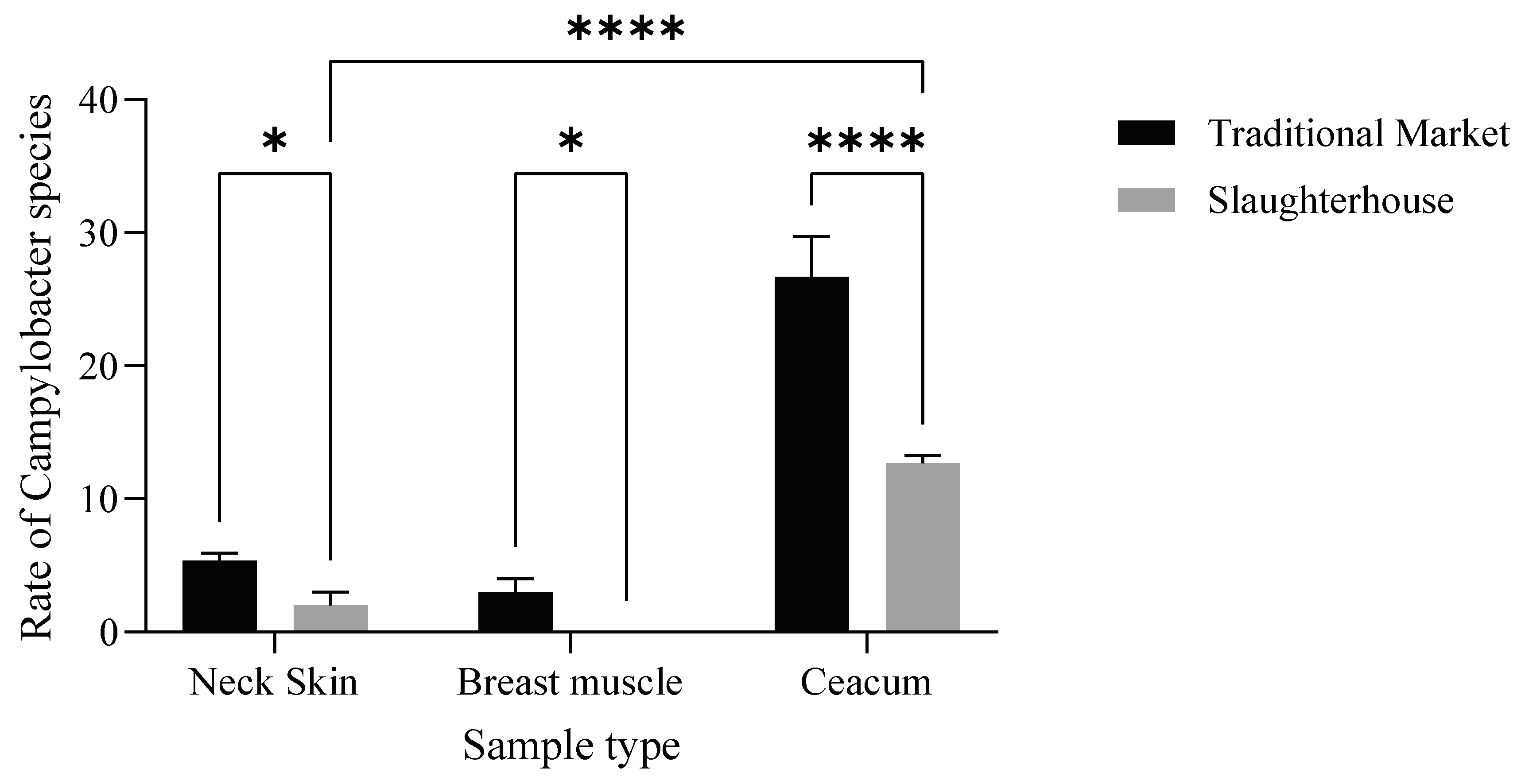
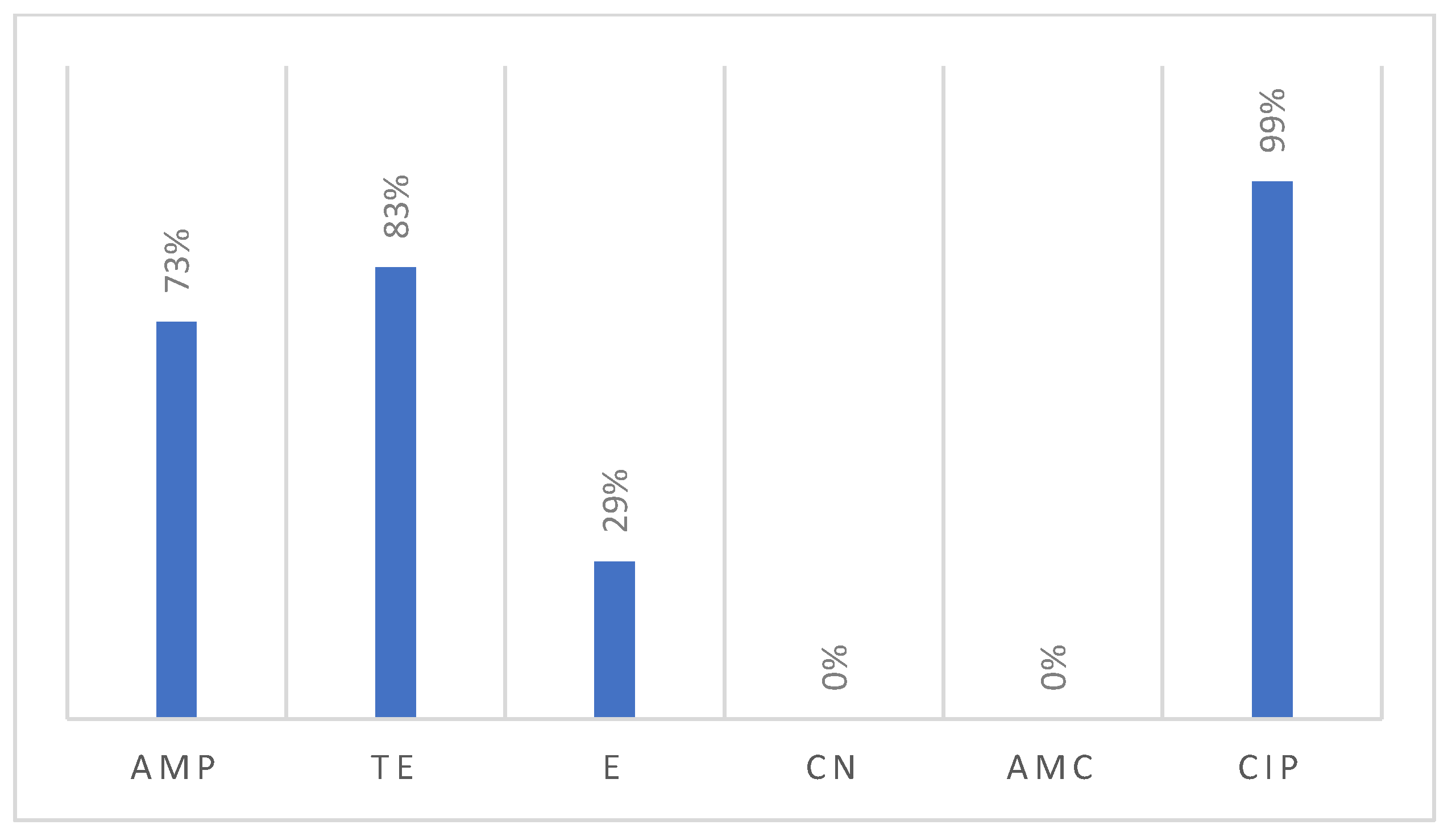
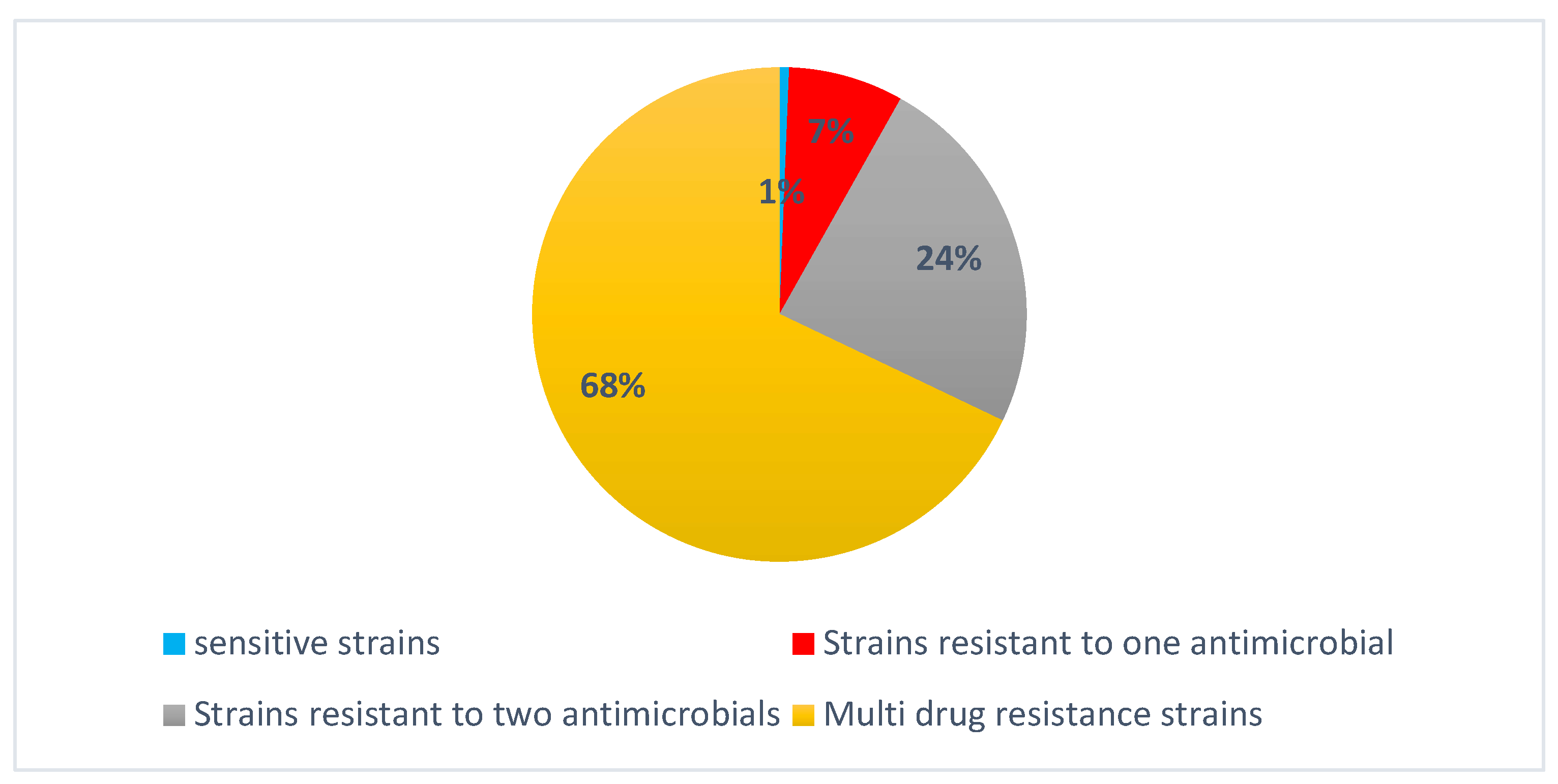
| Gene | Primer | Primer Sequence (5′-3′) | PCR Conditions | Product (pb) | Reference |
|---|---|---|---|---|---|
| Tet(O) | DMT1 | GGCGTTTTGTTTATGTGCG | Forward | 559 pb | El-Adawy et al., 2012 [13] |
| DMT2 | ATGGACAACCCGACAGAAGC | Reverse |
| Antibiotic Class | Rate of Resistance | |
|---|---|---|
| C. coli | C. jejuni | |
| Ampicillin (10 μg) | 75.18% | 61.53% |
| Tetracyclin (30 μg) | 80.45% | 96.15% |
| Erythromycin (15 μg) | 35.33% | 19.23% |
| Ciprofloxacin (5 μg) | 99.24% | 100% |
| Gentamicin (10 μg) | 0% | 0% |
| Amoxicillin and clavulanic acid (20/10 μg) | 0% | 0% |
| Strain Resistance | Number of Strains | Resistance Profile |
|---|---|---|
| Strain resistant to one antimicrobial | 12 | CIP |
| Strain resistant to two antimicrobials | 11 | CIP-AMP |
| 27 | CIP-TET | |
| Strain resistant to three antimicrobials | 61 | CIP-TET-AMP |
| 6 | CIP-AMP-E | |
| Strain resistant to four antimicrobials | 41 | CIP-TET-AMP-E |
Disclaimer/Publisher’s Note: The statements, opinions and data contained in all publications are solely those of the individual author(s) and contributor(s) and not of MDPI and/or the editor(s). MDPI and/or the editor(s) disclaim responsibility for any injury to people or property resulting from any ideas, methods, instructions or products referred to in the content. |
© 2025 by the authors. Licensee MDPI, Basel, Switzerland. This article is an open access article distributed under the terms and conditions of the Creative Commons Attribution (CC BY) license (https://creativecommons.org/licenses/by/4.0/).
Share and Cite
Soubai, Z.; Ziyate, N.; Darkaoui, S.; Rais, R.; Fellahi, S.; Attarassi, B.; Auajjar, N. Antimicrobial Susceptibility Profiles of Campylobacter jejuni and Campylobacter coli Isolated from Processed Chickens and Turkeys in Morocco. Poultry 2025, 4, 23. https://doi.org/10.3390/poultry4020023
Soubai Z, Ziyate N, Darkaoui S, Rais R, Fellahi S, Attarassi B, Auajjar N. Antimicrobial Susceptibility Profiles of Campylobacter jejuni and Campylobacter coli Isolated from Processed Chickens and Turkeys in Morocco. Poultry. 2025; 4(2):23. https://doi.org/10.3390/poultry4020023
Chicago/Turabian StyleSoubai, Zineb, Nadia Ziyate, Sami Darkaoui, Rim Rais, Siham Fellahi, Benaissa Attarassi, and Nabila Auajjar. 2025. "Antimicrobial Susceptibility Profiles of Campylobacter jejuni and Campylobacter coli Isolated from Processed Chickens and Turkeys in Morocco" Poultry 4, no. 2: 23. https://doi.org/10.3390/poultry4020023
APA StyleSoubai, Z., Ziyate, N., Darkaoui, S., Rais, R., Fellahi, S., Attarassi, B., & Auajjar, N. (2025). Antimicrobial Susceptibility Profiles of Campylobacter jejuni and Campylobacter coli Isolated from Processed Chickens and Turkeys in Morocco. Poultry, 4(2), 23. https://doi.org/10.3390/poultry4020023







